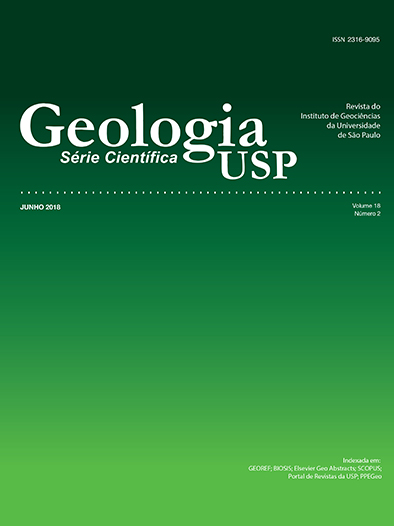Post-silurian reactivations of the Transbrasiliano Lineament in the southern portion of the Parnaíba Basin
DOI:
https://doi.org/10.11606/issn.2316-9095.v18-134712Keywords:
Parnaíba Basin, Transbrasiliano Lineament, Structural evolution.Abstract
The Transbrasiliano lineament trends NE-SW, and about 900 km of it occurs in the substrate of the Parnaíba Basin, inferred to be a plastic shear zone with dextral strike-slip kinematics based on geological and geophysical data. This paper addresses the structural signature and age of Transbrasiliano lineament reactivations in the southern region of the basin, east of the city of Palmas. In the crystalline basement, a late, ductile-brittle stage of Transbrasiliano lineament also displays dextral kinematics of ediacara-cambrian age, as observed in NW Ceará State. In the lithostratigraphic units of the Parnaíba Basin, reactivation events under brittle or hydroplastic conditions are recognized. In the studied region, an older event of sinistral transcurrent kinematics is expressed by NE-trending deformation bands and faults, combined with oblique structures, either dilatational (including joints and normal faults) or conjugate/antithetic strike-slip or oblique-slip structures. Their orientation ranges from NNE to NNW, as observed in the Sambaíba, Pedra de Fogo and older formations. In the southeast of Alto Parnaíba, evidence of neopermian, syndepositional tectonic activity was observed. A second set of structures is extensional joints or oblique-slip and normal faults associated to a N/NNW extension, overprinted in the eojurassic basic rocks of the Mosquito Suite. Sandstones bearing volcanic clasts were correlated to the Corda Formation and overly basic sills. A third set of structures, characterized by NE-trending normal or oblique faults, reflects a NW extension, as it is correlated to the rifting event in the Brazilian Eastern Margin during the Eocretaceous. Finally, a fourth event, with a more restrict occurrence, involves NE extension, as it is also observed in the Urucuia Group sandstones, implying a Neocretaceous age for this event.
Downloads
Downloads
Published
Issue
Section
License
Authors who publish in this journal shall comply with the following terms:
- Authors keep their copyright and grant to Geologia USP: Série Científica the right of first publication, with the paper under the Creative Commons BY-NC-SA license (summary of the license: https://creativecommons.org/licenses/by-nc-sa/4.0 | full text of the license: https://creativecommons.org/licenses/by-nc-sa/4.0/legalcode) that allows the non-commercial sharing of the paper and granting the proper copyrights of the first publication in this journal.
- Authors are authorized to take additional contracts separately, for non-exclusive distribution of the version of the paper published in this journal (publish in institutional repository or as a book chapter), granting the proper copyrights of first publication in this journal.
- Authors are allowed and encouraged to publish and distribute their paper online (in institutional repositories or their personal page) at any point before or during the editorial process, since this can generate productive changes as well as increase the impact and citation of the published paper (See The effect of Open Access and downloads on citation impact).





